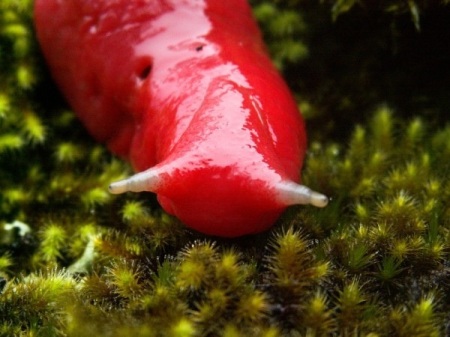[It’s] big. [It’s] slimy. And [it’s] … neon pink?! Meet Triboniophorus aff. graeffei, a new species of 8-inch-long (20-centimeter-long) slug that’s found only on one Australian mountain.
Scientists already knew that a bright-pink slug lived on Mount Kaputar, thinking it was a variety of the red triangle slug, a species common along the east coast of Australia. But new research shows that the colorful critter is actually its own species, said Australia’s National Parks and Wildlife Service ranger Michael Murphy.

The pink slug is large for slugs, reaching about eight inches in length
Photograph © Michael Murphy / NPWS
“Recent morphological and genetics work by a researcher working on this slug family—the Athorcophoridae—has indicated the Kaputar slugs are a unique species endemic to Mount Kaputar and the only representative of this family in inland Australia,” said Murphy, who’s been stationed on Mount Kaputar for 20 years.
The pink slug had gone unstudied for so long because Australian slug and snail researchers—known as malacologists—are far outnumbered by their koala-investigating brethren, Murphy said. Their research on the new slug will likely be submitted for publication soon, he added. Meanwhile, though, the Australian government has moved to protect this rosy rarity and other unique species by designating their mountain home in New South Wales as an ”endangered ecological area.”
Tens of millions of years ago, Australia was part of a larger southern continent known as Gondwana, which included Australia, Papua New Guinea, India, and parts of Africa and South America. It was covered in rain forests similar to those of modern-day Papua New Guinea.

Photograph © Michael Murphy / NPWS
A volcanic eruption 17 million years ago on Mount Kaputar kept a small, four-square-mile (ten-square-kilometer) area lush and wet even as much of the rest of Australia turned to desert. This changing environment marooned the plants and animals living on Mount Kaputar from their nearest neighbors for millions of years, making the area a unique haven for species such as the pink slug.
Because the pink slugs live in beds of red eucalyptus leaves, Murphy suspects their color could potentially serve as camouflage, helping the animals blend in to their leafy habitat. “However, [the slugs] also spend a lot of their time high on tree trunks nowhere near fallen leaves, so it is possible that the color is just a quirk of evolution. I think if you are isolated on a remote mountaintop, you can pretty much be whatever color you like,” Murphy noted, adding that the slugs play important roles in their ecosystems—for example, by recycling plant matter.
“I’m a big believer in invertebrates. People tend to focus on the cute and cuddly bird and mammal species like koalas. But these little behind-the-scenes invertebrates really drive whole ecosystems,” Murphy told the Australian Broadcasting Service. Besides the pink slug, researchers have also identified several other invertebrate species that are unique to Mount Kaputar, such as the Kaputar hairy snail and the Kaputar cannibal snail.
These finds, combined with Mount Kaputar’s uniqueness and the growing threat from global warming—temperatures just a degree or two warmer would destroy Kaputar’s flora and fauna—prompted the Australian government’s proposal to preserve Kaputar. “They are a unique and colorful part of our natural heritage, and we should do everything we can to avoid causing their extinction,” Murphy said.
Source: Nat Geo
* Showing my age
